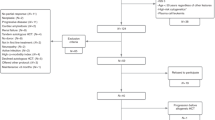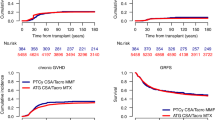Abstract
This study compares the probability of disease progression, progression-free survival, and overall survival between patients undergoing an allogeneic or autologous transplant for multiple myeloma using an identical preparative regimen. Patients received a preparative regimen of TBI, busulfan, and cyclophosphamide followed by an allogeneic or autologous transplant. In the allogeneic group (n = 21), six patients received bone marrow and 15 received G-CSF mobilized PBSC; all autologous patients (n = 35) received PBSC mobilized with cyclophosphamide and G-CSF. Allogeneic donors were HLA-identical (n = 20) or one-antigen mismatched (n = 1) siblings. Graft-versus-host disease (GVHD) prophylaxis consisted of tacrolimus (n = 10), tacrolimus/methotrexate (n = 6), cyclosporine/methotrexate (n = 4), or cyclosporine (n = 1). The groups were evenly matched for gender, pretransplant therapy, disease status at time of transplant, myeloma subtype, and time from diagnosis to transplant. The median age was significantly lower in the allogeneic group (48 vs 55 years, P < 0.01). In the allogeneic group the probabilities of developing acute GVHD grade II-IV and chronic GVHD were 55% and 82%, respectively. The Kaplan–Meier probability of disease progression was significantly lower in the allogeneic group (11% vs 64%, P < 0.001) compared to the autologous group. Although progression-free (60% vs 30%, P = 0.19) and overall survival at 2 years (60% vs 42%, P = 0.39) favored the allogeneic group, this did not reach statistical significance. Within the allogeneic transplant group, patients age 50 years or under had a 3-year overall survival significantly higher when compared to older patients (79% vs 29%, P = 0.03). Using identical preparative regimens, allogeneic transplantation reduced disease progression compared to autologous transplantation for myeloma. This suggests that allogeneic transplantation induces a graft-versus-myeloma (GVM) effect. Bone Marrow Transplantation (2001) 27, 801–807.
This is a preview of subscription content, access via your institution
Access options
Subscribe to this journal
Receive 12 print issues and online access
$259.00 per year
only $21.58 per issue
Buy this article
- Purchase on SpringerLink
- Instant access to full article PDF
Prices may be subject to local taxes which are calculated during checkout




Similar content being viewed by others
References
Cunningham D, Paz-Ares L, Gore ME et al. High-dose melphalan for multiple myeloma: long-term follow-up data J Clin Oncol 1994 12: 764–768
Barlogie B, Hall R, Zander A et al. High-dose melphalan with autologous bone marrow transplantation for multiple myeloma Blood 1986 67: 1298–1301
Attal M, Harousseau JL, Stoppa AM et al. A prospective, randomized trial of autologous bone marrow transplantation and chemotherapy in multiple myeloma. Intergroupe Francais du Myelome New Engl J Med 1996 335: 91–97
Gahrton G . Treatment of multiple myeloma Lancet 1999 353: 85–86
Mehta J, Singhal S . Graft-versus-myeloma Bone Marrow Transplant 1998 22: 835–843
Bjorkstrand BB, Ljungman P, Svensson H et al. Allogeneic bone marrow transplantation versus autologous stem cell transplantation in multiple myeloma: a retrospective case-matched study from the European Group for Blood and Marrow Transplantation Blood 1996 88: 4711–4718
Slavin S, Nagler A, Naparstek E et al. Nonmyeloablative stem cell transplantation and cell therapy as an alternative to conventional bone marrow transplantation with lethal cytoreduction for the treatment of malignant and nonmalignant hematologic diseases Blood 1998 91: 756–763
Bacigalupo A . Hematopoietic stem cell transplants after reduced intensity conditioning regimen (RI-HSCT): report of a workshop of the European Group for Blood and Marrow Transplantation (EBMT) Bone Marrow Transplant 2000 25: 803–805
Lokhorst HM, Sonneveld P, Cornelissen JJ et al. Induction therapy with vincristine, adriamycin, dexamethasone (VAD) and intermediate-dose melphalan (IDM) followed by autologous or allogeneic stem cell transplantation in newly diagnosed multiple myeloma Bone Marrow Transplant 1999 23: 317–322
Varterasian M, Janakiraman N, Karanes C et al. Transplantation in patients with multiple myeloma: a multicenter comparative analysis of peripheral blood stem cell and allogeneic transplant Am J Clin Oncol 1997 20: 462–466
Bensinger WI, Rowley SD, Demirer T et al. High-dose therapy followed by autologous hematopoietic stem-cell infusion for patients with multiple myeloma J Clin Oncol 1996 14: 1447–1456
Bensinger WI, Buckner CD, Anasetti C et al. Allogeneic marrow transplantation for multiple myeloma: an analysis of risk factors on outcome Blood 1996 88: 2787–2793
Durie BG, Salmon SE . A clinical staging system for multiple myeloma. Correlation of measured myeloma cell mass with presenting clinical features, response to treatment, and survival Cancer 1975 36: 842–854
Uberti JP, Silver SM, Adams PT et al. Tacrolimus and methotrexate for the prophylaxis of acute graft-versus-host disease in allogeneic bone marrow transplantation in patients with hematologic malignancies Bone Marrow Transplant 1997 19: 1233–1238
Cox DR . Regression models and life-tables J Stat Soc 1972 34: 187–220
Kaplan EL, Meier P . Nonparametric estimation from incomplete observations J Am Stat Assoc 1958 53: 457–481
Kulkarni S, Powles RL, Treleaven JG et al. Impact of previous high-dose therapy on outcome after allografting for multiple myeloma Bone Marrow Transplant 1999 23: 675–680
Desikan KR, Tricot G, Dhodapkar M et al. Melphalan plus total body irradiation (MEL-TBI) or cyclophosphamide (MEL-CY) as a conditioning regimen with second autotransplant in responding patients with myeloma is inferior compared to historical controls receiving tandem transplants with melphalan alone Bone Marrow Transplant 2000 25: 483–487
Barlogie B, Jagannath S, Naucke S et al. Long-term follow-up after high-dose therapy for high-risk multiple myeloma Bone Marrow Transplant 1998 21: 1101–1107
Gahrton G, Svensson H, Apperly J et al. Progress in allogeneic hematopoietic stem-cell transplantation for multiple myeloma Bone Marrow Transplant 2000 25: (Suppl. 1) 140a
Bensinger WI, Martin PJ, Storer B et al. Transplantation of bone marrow as compared with peripheral-blood cells from HLA-identical relatives in patients with hematologic cancers New Engl J Med 2001 344: 175–181
Powles R, Mehta J, Kulkarni S et al. Allogeneic blood and bone-marrow stem-cell transplantation in haematological malignant diseases: a randomised trial Lancet 2000 355: 1231–1237
Lokhorst HM, Schattenberg A, Cornelissen JJ et al. Donor lymphocyte infusions for relapsed multiple myeloma after allogeneic stem-cell transplantation: predictive factors for response and long-term outcome J Clin Oncol 2000 18: 3031–3037
Lokhorst HM, Schattenberg A, Cornelissen JJ et al. Donor leukocyte infusions are effective in relapsed multiple myeloma after allogeneic bone marrow transplantation Blood 1997 90: 4206–4211
Tricot G, Vesole DH, Jagannath S et al. Graft-versus-myeloma effect: proof of principle Blood 1996 87: 1196–1198
van der Griend R, Verdonck LF, Petersen EJ et al. Donor leukocyte infusions inducing remissions repeatedly in a patient with recurrent multiple myeloma after allogeneic bone marrow transplantation Bone Marrow Transplant 1999 23: 195–197
Martinelli G, Terragna C, Zamagni E et al. Molecular remission after allogeneic or autologous transplantation of hematopoietic stem cells for multiple myeloma J Clin Oncol 2000 18: 2273–81
Acknowledgements
This work was supported in part by the General Clinical Research Center of the University of Michigan (M01-RR00042).
Author information
Authors and Affiliations
Rights and permissions
About this article
Cite this article
Reynolds, C., Ratanatharathorn, V., Adams, P. et al. Allogeneic stem cell transplantation reduces disease progression compared to autologous transplantation in patients with multiple myeloma. Bone Marrow Transplant 27, 801–807 (2001). https://doi.org/10.1038/sj.bmt.1703006
Received:
Accepted:
Published:
Issue date:
DOI: https://doi.org/10.1038/sj.bmt.1703006
Keywords
This article is cited by
-
A plethora of ocular surface manifestations in a multidisciplinary ocular graft-versus-host disease unit
Scientific Reports (2022)
-
Role of allogeneic stem cell transplantation in multiple myeloma
Current Hematologic Malignancy Reports (2008)
-
Prognostic factors for donor lymphocyte infusions following non-myeloablative allogeneic stem cell transplantation in multiple myeloma
Bone Marrow Transplantation (2006)
-
Second autologous transplant with cyclosporin/interferon α-induced graft versus host disease for patients who have failed first-line consolidation
Bone Marrow Transplantation (2004)
-
Outcome after autologous and allogeneic stem cell transplantation for patients with multiple myeloma: impact of graft-versus-myeloma effect
Bone Marrow Transplantation (2003)



